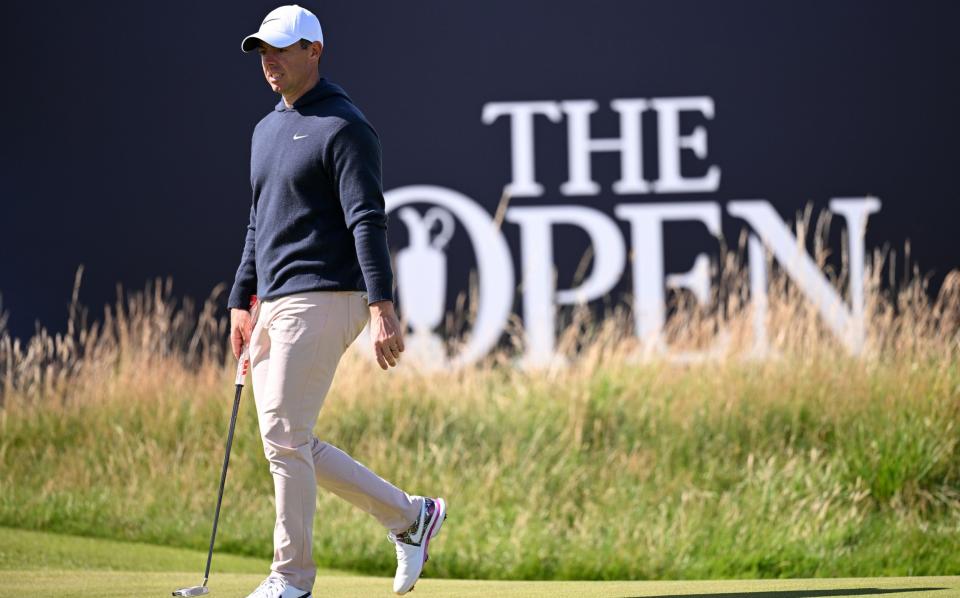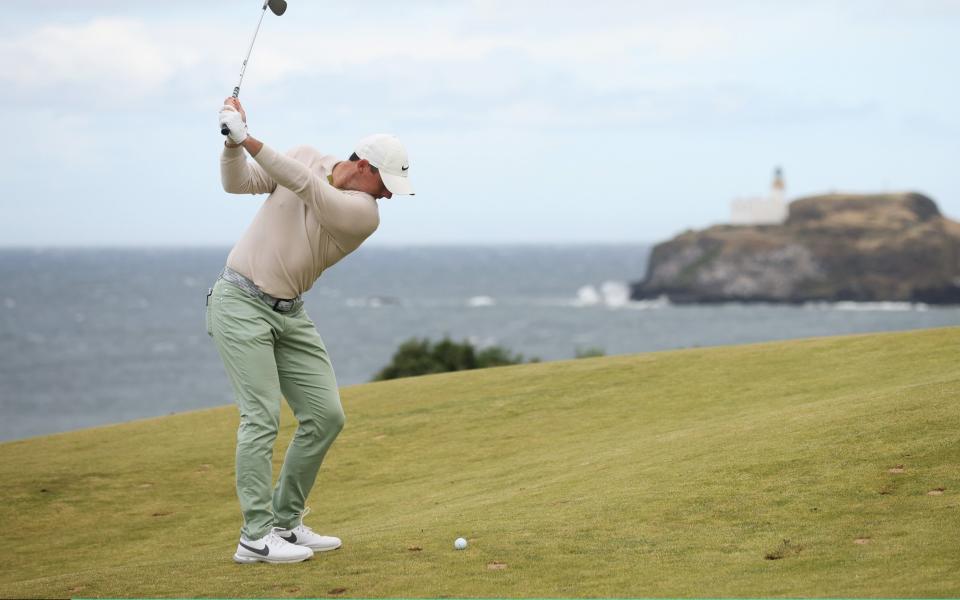
Rory McIlroy’s astonishing two-iron on Sunday was not only exhilarating because it effectively won the Northern Irishman the Scottish Open and his first title in six months, but because of what it might mean to his chances of a first major title in nine years here at the 151st Open.
Granted the superlative strike under the wind from 201 yards signified that McIlroy is in peak form as he returns to Royal Liverpool, this Wirral links is where he lifted his one and so far only Claret Jug in 2014. Yet, just as pertinently, it showed that he has the special weapon in his holster that could give him the edge over the world’s best.
In short, he has the two-iron and armed with the fabled club that in the game’s origins was called “The Cleek” – a narrow metal-headed club with a slight loft – the world No 3 is in a special clique this week.
It is fair to say that The Cleek holds a cherished place in Hoylake’s recent Open folklore. In 2006, the course’s first major in 39 years, Tiger Woods famously only used the driver once all week, instead conjuring his two-iron stinger off the tee, over and over.
Woods developed a gameplan and his unique mix of exuberant skill and chess-like patience allowed him to fire into the greens from further back than his driver-wielding colleagues, but always from the fairway, an asset he was convinced would pay dividends. The performance is still classified by the disciples of discipline as the benchmark of consummate golf control.
“There were not many in that Open field, even back then, who also had the two-iron in the bag,” Ian Poulter says. “The advance of the ball had made it easier to hit five-woods and hybrids, because of the absence of spin. And there were probably even fewer when the Open returned there eight years later.”
McIlroy was one of those. Except the conditions were different – far more lush and without the run – allowing one of the greatest exponents of the driver of all time to blast off the tees. Yet he did bring it into play. “Oh yeah, it was in there,” he told Telegraph Sport, as he reminisced about his two-shot triumph. “My last iron shot in that tournament was actually with a two-iron.”

Of course the two-iron on Sunday was the last iron shot at the Renaissance Club as well and he unsurprisingly expressed his satisfaction at his decision to introduce the Taylor P760. “I put it in for these two weeks,” he said. “So it’ll again be in my bag for Hoylake.”
When asked if he felt it was a risk “because not many other players use it nowadays”, he replied: “Yeah, but they’re not as good as me.”
McIlroy said that with a smile and was clearly joking. But if many true things are said in jest, then his former coach, Pete Cowen, believes that this quip borders on the thrillingly factual. “The one-iron and two-iron have already separated the men from the boys and, in some senses, that probably follows more than ever,” he said.
It is complex because McIlroy launches the ball higher (and farther) than most pros, which gives him an advantage when playing in the US, where the elements follow an aerial style. But besides the UK seasides, punching the ball lower and with less spin protects the trajectory through the gusts.
With this in mind, McIlroy went back to the 17-degree, two-iron that was made for him by TaylorMade a few years ago. It was in the garage at his Florida mansion gathering dust. Within a fortnight it could gather not only that first Scottish Open title but that elusive fifth major. McIlroy’s superior talent has always been undoubted, but with equipment technology creating this false era of parity, this could be the faculty at last to set apart his ability again.
“There is that old joke from Lee Trevino [the Texan who said that during a thunderstorm anybody on a golf course should simply hold his one iron up to the sky – “because even God can’t hit a one iron] and Lee knew what he was talking about,” Cowen said.
Cowen pointed out that this era’s two-iron is essentially the one-iron from the end of the last century. With hackers obsessed with distance, the equipment-makers altered the air. So a mid-handicapper believed he was hitting his seven iron in his new set a lot longer than the one from his old set, when in reality that was because the loft was three degrees different, from 33 degrees to 30 degrees. The one-iron was as much as 19 degrees.

The cynical marketing ploy was destined to bite back, because the lower the loft, the harder to hit, but the invention of the hybrid means that the overwhelming majority of full sets sold in golf shops nowadays go from four-irons to pitch wedges, with the proliferation of lob wedges opening up an entirely fresh sales division.
“The modern ball is so much more forgiving and the woods and hybrids so much more relatively easy to hit,” Cowen confirmed. “You don’t see the “driving” irons much any more. And although it is about getting more people playing the game and making it easier to get round, that is a shame, because it’s an art and qualifies the golfer as a great ball-striker.”
Cowen was a pro in the Seventies through to the mid-Eighties and becomes almost misty eyed with the memories. “Sandy Lyle was the best with those clubs back in the day,” he said. “They called the one-iron the ‘cake knife’, but Sandy’s was more like a dinner knife, dead flat and with a face so small. You’d look at him being dwarfed by the ball, with no sweet spot, and think how does he do it every time? It’s the consistency the modern players are worried about.
“But not Rory, or Brooks [Koepka, the five-time major winner who Cowen coaches]. Brooks has a club with the loft of a two-iron, or old one-iron, and like Rory, is confident that he can do what others can’t with it. If it gets windy here – and it is supposed to – then it could be a defining advantage – as Rory displayed on Sunday.”
Tommy Fleetwood is another ball-striker who would be fancied to wield the flat-face with panache. Yet last week he was unsure if he would employ it and explained why. “There is no doubt that the modern ball does a lot less than it used to do in terms of spin, so even if you send a five-wood skybound in the wind, it is not going to fly off like confetti,” he said . “And if you are going to bring along the two-iron just for two weeks you have to have a lot of self-belief.
“There is the risk factor, because no matter how well you might hit it in practice, can you rely on it in competition? You definitely don’t see the pros messing with the set-ups as much as they used to and that must be due to the equipment and just where the game has gone.
“But yeah, it’s nostalgic to think about the people who could hit one-irons and two-irons. I remember watching Tiger win in 2006 and then running to the range to hit a two-iron for the next week or so.”
The golfers who eschewed the fairway woods were once a revered species. “I suppose it was a status symbol – ‘hey have you seen him, he can hit a one-iron!'” Fleetwood said. “So you put a one-iron in, but whether you could hit it or not was a different matter. I played with Gareth Jones, the pro at Sandiway [Golf Course in Cheshire] a few years back, and I looked at his clubs and he had a driver and then a one-iron all the way through to his wedges and putter. I told him ‘that’s my favorite club set-up ever’. It was old school and I loved it. Maybe those days have gone now, though.”
Yet McIlroy’s strike of genius might mean that “The Cake Knife” still has its purpose and perhaps it should not be consigned to the bottom drawer to go rusty and forgotten. And with the governing bodies threatening to roll back the ball to solve the game’s great distance issue perhaps Hoylake will produce another flat-faced blow for the flushers of yesteryear.
“There’s no thrill like hitting a two-iron like that on the 18th to win,” McIlroy said. “Pure.”
Broaden your horizons with award-winning British journalism. Try The Telegraph free for 1 month, then enjoy 1 year for just $9 with our US-exclusive offer.